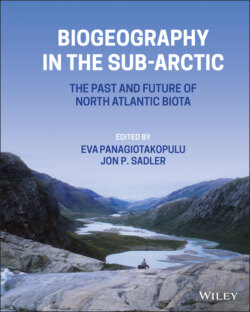Читать книгу Biogeography in the Sub-Arctic - Группа авторов - Страница 36
Faroe Islands
ОглавлениеThe Faroe Islands are patchy sub‐aerial remnants of a previously extensive Paleogene lava sequence that is considered part of the Brito‐Arctic Igneous (floral) Province (BIP; Figure 1). The strata composing the Faroes are named the Faroe Islands Basalt Group (Passey and Jolley 2009). The stratigraphic thickness of exposed rock is ca. 3.2 km, with additional ca. 3.4 km thick subsurface units documented from boreholes. Recently, the stratigraphy and age of the Faroe Islands has been summarized and revised (cf. Riisager et al. 2002; Passey and Jolley 2009). The strata are subdivided into seven formations. The Lopra Formation is the basal volcanic construction, known only from boreholes, and is succeeded by the geochemically different Beinisvørð Formation. Most of the few reported plant macrofossils from the Faroe Islands (e.g. Hartz 1903; Rasmussen and Koch 1963) originate from the upper half of this formation, in an outcrop on the island Mykines (Mykines flora). The lavas of the Beinisvørð Formation are overlain by sedimentary rocks of the Prestfjall Formation. These sedimentary rocks contain two coal seams and associated silt and sandstones (Rasmussen and Noe‐Nygaard 1969). The palynological content of this formation (Prestfjall flora) has been studied by Laufeld (1965) and Lund (1989) from outcrops on the island Suðuroy. The sedimentary rocks of the Prestfjall Formation are succeeded by pyroclastics and lavas of the Hvannhagi and Malistindur Formations and the volcaniclastics and lavas of the Sneis and Enni Formations (e.g. Passey and Jolley 2009). Radiometric dating of lavas from the Faroe Islands and corresponding lavas on Greenland show that basalts below the Prestfjall Formation are ca. 60–56 Ma and volcanics above the Prestfjall Formation are ca. 56–54 Ma (e.g. Waagstein et al. 2002; Storey et al. 2007; Passey and Jolley 2009). Stratigraphic correlation of the plant‐bearing sedimentary rock units on Mykines with Waagstein et al. (2002) suggest they are ca. 58 Ma and of late Palaeocene age (late Thanetian), but those of the Prestfjall Formation are just under 56 Ma and of early Eocene age (earliest Ypresian; Figure 2).
Figure 6 Eocene fossil pollen from Hareø, West Greenland. (A, B) Fagus sp. (C, D) Castaneoideae gen. et spec. indet. (E, F) Quercus plesiomorphic pollen type of Quercus; identical to extant pollen of Quercus sect. Ilex. (G, H) aff. Eotrigonobalanus sp. (I, J) Quercus sp. (K, L) Quercus sect. Lobatae/Quercus. (M, N) Spirematospermum sp. (O, P) Aponogeton sp.
Figure 7 Eocene fossil leaves from Hareø, West Greenland. (A) Fagus sp., S110238. (B) Aponogeton sp., S110339. (C) Aponogeton sp., S110337.
Plant macrofossils have been known from the Faroe Islands since 1901 (see Hartz 1903). Until now the only detailed description is of Metasequoia vegetative long and short shoots (Rasmussen and Koch 1963; Figure 3E). Remains of other Cupressaceae have also been recorded and believed to represent Sequoia, Taxodium and Juniperus. The few fragmentary angiosperm leaf fossils recovered have been considered unidentifiable (Hartz 1903; Rasmussen 1925; Rasmussen and Koch 1963). Despite the current lack of macrofossils from the Faroe Island, two previous light microscopic palynological studies by Laufeld (1965) and Lund (1989) suggest that a rather diverse palaeovegetation existed during the accumulation of the early Eocene coal‐bearing Prestfjall Formation.
The early Eocene palynological assemblage was characterized by swamp forests and riparian elements comprising several ferns, taxodiaceous Cupressaceae (intermittently amounting to over 30% of the palynological assemblage), Juglandaceae and Betulaceae. On more mesic sites Fagaceae, Juglandaceae and other eudicots may have thrived along with Pinus, Sciadopitys and possibly Sequoia.
